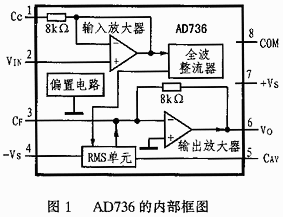1 Overview
With the rapid advancement of integrated circuits, true RMS AC/DC converters have emerged in recent years. Among these, the AD736 from the American AD company stands out. This chip is designed to provide an accurate measurement of both AC and DC voltages, ensuring compatibility with a wide range of waveforms.
In scientific and industrial applications, we frequently encounter non-sinusoidal signals. Traditional measurement tools often rely on the average conversion method, which introduces significant theoretical errors. To address this issue, true RMS conversion techniques have been developed. These methods directly convert the RMS value of AC signals into a DC equivalent without relying on average conversions. As a result, modern multimeters equipped with true RMS capabilities have seen rapid growth in demand. True RMS measurements are achieved through a series of operations: squaring the input AC voltage, averaging it, and then taking the square root to obtain the RMS value. One major advantage of true RMS meters is their ability to precisely measure the RMS values of various waveforms regardless of the signal's parameters or distortions.
The AD736 is a laser-corrected, monolithic precision true-RMS AC/DC converter. It boasts several key features, including high accuracy, excellent sensitivity (with a full-scale range of 200mVRMS), fast measurement rates, broad frequency response (up to 0–460kHz), high input impedance, low output impedance, and low power consumption (a maximum operating current of just 200μA). For sine wave voltage measurements, its integrated error does not exceed ±3%.
2 Working Principle and Pin Function
The internal block diagram of the AD736 is illustrated in Figure 1. It consists primarily of an input amplifier, a full-wave rectifier, an RMS unit (commonly referred to as the RMS core RMS CORE), a bias circuit, and an output amplifier. The second pin of the chip serves as the input signal VIN. During operation, the measured signal voltage is applied to the non-inverting input of the input amplifier. The output voltage is then full-wave rectified and sent to the RMS unit, where it is converted into a representative RMS value. This DC voltage is subsequently output through the Vo terminal of the output amplifier. The bias circuit functions to provide an appropriate bias voltage for each internal unit circuit within the chip.

As technology continues to evolve, devices like the AD736 are becoming increasingly important in fields such as telecommunications, medical electronics, and consumer electronics. Their ability to handle complex waveforms and provide precise measurements makes them indispensable in modern engineering. Additionally, the integration of advanced features like low power consumption ensures that they remain relevant even in energy-constrained environments. Engineers and researchers are continuously exploring new ways to optimize these chips, enhancing their performance and expanding their applications. Whether it’s monitoring power quality, analyzing audio signals, or improving medical diagnostics, the AD736 remains a vital tool in countless applications worldwide.
Bang De 8500 Puffs,Rechargeable Disposable Kit 8500 Puffs,Bang Vape 8500 Puff Electronic Cigarette
Longhua Manxueling Trading Company , https://www.mxlvape.com
